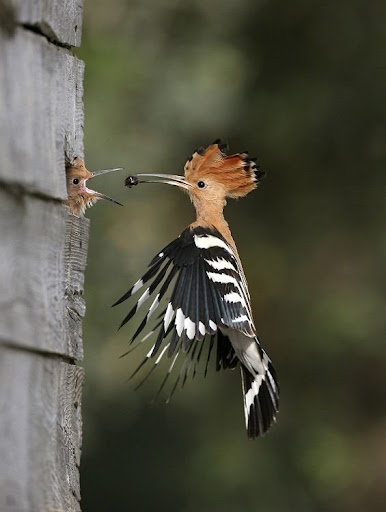Hoopoe (Upupa epops) is an unusual name for an unusual looking bird found throughout Afro-Eurasia. This bird has a black and white barred tail and wings, a creamy, peach colored body, a long, thin beak, and most notably a large crest of feathers tipped in black and white on the top of its head. Its wings are short and rounded and it flies in an undulating motion that is said to be similar to butterfly flight. It is a medium sized bird about 9.8-12.6 inches in length. The hoopoe actually gets its English name from the sound it makes while singing. The song is a deep, haunting ‘oop oop oop’ that has led to the bird being associated with death and the Underworld in Estonian tradition. The song itself is said to forebode death. Across the majority of Europe, it was thought of as a thief and as a harbinger of war in Scandinavia. However, the hoopoe is considered good in most other cultures because it eats many insects that are considered to be pests. In Ancient Egypt, the hoopoe was a sacred bird and depictions of it can be found on the walls of Egyptian temples and tombs. The people of Minoan Crete held similar beliefs about it. Over most of its range, the hoopoe is a protected bird and it is illegal to harm or kill it.
Hoopoes mostly feed on insects of all sorts, but will also eat some types of berries and seeds on occasion. They mainly forage on the ground and poke their beak into soil to hunt for insect larvae or worms. Sometimes they will even flip over rocks with their beak or use their feet to dig out creatures they find in the dirt.
They nest in the cavities of trees, cliffs, abandoned animal holes, or sometimes manmade structures such as nest boxes and walls. Pairs form monogamous bonds for one breeding season only, but it remains strong throughout this period. Males will become very territorial and verbally advertise ownership of their mate and their nesting area, often chasing off or getting into fights with other males and sometimes females. These fights are actually quite intense and can occasionally lead to a bird being blinded by a rival’s sharp beak.

Bird fight!
A female hoopoe lays a varying number of eggs depending on her location. In tropic and subtropic regions, average clutch size is around seven whereas in central or Northern Europe and Asia it is generally twelve. She is the sole incubator of the eggs and the male brings her food while she sits on them. During this time, the hoopoe’s preening gland found at the base of the tail, normally used to produce oil for the feathers, starts to secrete an unpleasant substance that smells similar to rotting meat. This is to make the bird unappealing to predators and may play a role in protecting against feather parasites. The baby hoopoes also produce this substance until they are out of the nest.

As you can see, this hoopoe found a nice hole in somebody’s wall.
The hoopoe is a migratory bird in most respects, but populations in Africa stay where they are year round. Most hoopoes in Europe and Northern Asia travel to the tropics to overwinter and return in the spring to breed then stay through the summer and early fall. During migration, these birds will often fly at high altitudes across the Himalayas and have even been recorded at heights of almost 21,000 feet above sea level! When not facing the perils and exhaustion of migration, hoopoes enjoy taking sunbaths together on warm days like scantily clad young women at the beach. Unlike tanning girls, though, they also love dust bathing. The dust they rub into their feathers helps clean them and rid them of parasites and other irritants.

Dust baths are great!

Catchin’ some rays.
I’ve never had the privilege of seeing this unique and beautiful bird since I live in the U.S., but if you live anywhere in Europe, Asia, or Africa, go try to find a few hoopoes and have some fun watching them run around on the ground searching for bugs or playing in the dirt. Maybe listen for the male’s pining song during breeding season and see if you find it to be eery and foreboding too like the Estonians once did.
References:
1. Seago, Michael. “The Hoopoe, Upupa Epops – a Colourful Bird.” Birds of Britain. N.p., n.d. Web. 21 May 2015. <http://birdsofbritain.co.uk/bird-guide/hoopoe.asp>.
2. Dupree, Nancy Hatch. “An interpretation of the role of the hoopoe in Afghan folklore and magic.” Folklore 85.3 (1974): 173-193.
3. Perrins, Christopher M. “Hoopoe.” Firefly Encyclopedia of Birds. Buffalo, NY: Firefly, 2003. 382. Print.
4. Hiiemäe, Mall. “Forty Birds in Estonian Folklore IV.” Mäetagused. N.p., n.d. Web. 21 May 2015.
5. Martín-Platero, Antonio M., et al. “Characterization of antimicrobial substances produced by Enterococcus faecalis MRR 10-3, isolated from the uropygial gland of the hoopoe (Upupa epops).” Applied and environmental microbiology 72.6 (2006): 4245-4249.
5. Cameron, Ad, Christopher M. Perrins, and Colin James Oliver. Harrison. “Hoopoes.” Birds: Their Life, Their Ways, Their World.Pleasantville, N.Y: Reader’s Digest Association, 1982. 304. Print.
Photo Links:
1.http://www.kimballstock.com/pix/BRD/13/BRD-13-WF0122-01P.JPG
2.http://upload.wikimedia.org/wikipedia/commons/c/c4/Young_and_mature_hoopoe.jpg
3.https://lh6.googleusercontent.com/_9XqcePo6Kh8/TbUycXovuhI/AAAAAAAAAr0/X8hCSVaUe_g/wood%20pecky.jpg
4.http://iberianature.com/lucyblog/wp-content/uploads/2008/07/hoopoe-on-path-4.jpg
5.https://creaturefacts.wordpress.com/wp-content/uploads/2015/05/453e4-22bdust2bbath.jpg